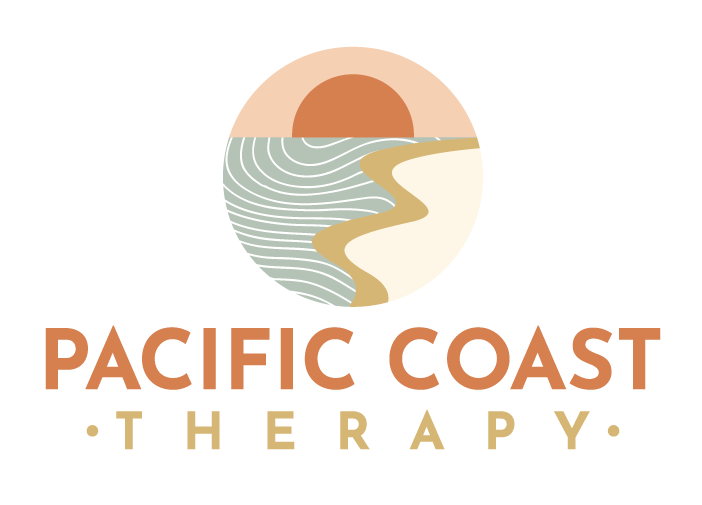When we feel these strong emotions, our sympathetic nervous system, commonly referred to as our fight, flight, or freeze responses, is activated. When these responses are activated our ability to regulate emotions, control impulses, and monitor or evaluate how we are affecting those around us is significantly impaired.
At Pacific Coast Therapy, we use a modality called Dialectical Behavioral Therapy (DBT) that encompasses many skills to help increase distress tolerance. In particular, our experienced therapists teach TIPP (temperature, intense exercise, paced breathing, and progressive muscle relaxation) skills to use when you are feeling any range of emotions at varying intensity. These techniques target the physiological symptoms of big emotions like body temperature, heart rate, sweating, and muscle tension. On an intensity scale of 0 (feeling really good) to 10 (feeling the worst of the big emotion), TIPP skills are meant to be used when you’re at a 5 or higher.
Each TIPP skill will help you reduce the intensity of the physiological symptoms you may be experiencing by activating the parasympathetic nervous system. Contrary to the sympathetic nervous system, the parasympathetic nervous system is responsible for helping you rest and recover. Once you have returned to a baseline after using a TIPP skill, you can effectively process the emotion by talking it out, writing about it, or using another preferred coping skill.
T is for Temperature:
The temperature skill is perhaps the quickest way to address the big emotion. This exercise is meant to be anywhere from 10-30 seconds and should be used when you are feeling between an 8-10 intensity level. Typically, the most effective way to use this skill is to dunk your face into a bowl of ice water or use a soft ice pack on your forehead. These actions activate your mammalian diving reflex, which is a survival instinct that provides immediate relief by slowing down your heart rate and breathing, decreasing sweating, and relaxing muscles. For individuals who may need a modification for this skill, perhaps try holding ice cubes, putting a cold towel on your neck, or taking a cold shower.
I is for Intense Exercise:
The intense exercise skill is one of the longer skills to complete. Typically, intense aerobic exercise should range from 10-20 minutes to be most effective and should be used when you feel between an 8-10 intensity level. Ideally, you will have a form of intense exercise that is immediately accessible such as punching a punching bag, using an elliptical, or going for a run. One of the essential functions of emotions is to prepare us for action. When emotions are intense, the body is primed for intense activity; intense exercise can release that part of the emotional experience. For individuals who may need a modification for this skill, try jumping jacks, dancing, or wall push-ups.
P is for Paced Breathing:
The paced breathing skill is meant to be used when you are between a 5-7 intensity level. This skill works by stabilizing your breathing pattern so that you have approximately five or six breaths per minute. Like the temperature skill, paced breathing also activates the parasympathetic nervous system to bring your body back to baseline. To complete this skill, breathe in deeply through your nose for about four seconds. Then, hold your breath in your belly for about five seconds. Finally, release the breath out of your mouth for about seven seconds. Repeat this pattern for about five minutes. It’s important to note that this skill may be too challenging when you are feeling between an 8-10 intensity level. For individuals who may need a modification for this skill, try reducing the number of seconds to 3 in, 4 holding, and 5 out.
P is for Progressive Muscle Relaxation:
The progressive muscle relaxation skill is another one to use when you are feeling a lower intensity, usually between a 5-7. To complete this skill, pick a point in your body to begin. Generally, starting at either the toes or the face is a good choice. Let’s say you begin at the toes. For about five to six seconds, breathe in while flexing your toes as hard as you can. Then for about five or six seconds, breathe out while slowly releasing the tension. Repeat this pattern as you make your way up your body. Key areas to address in the body while using this skill include toes, ankles, calves, thighs/quads, stomach, shoulders, biceps, hands, and face. For individuals who may need a modification for this skill, try not squeezing as hard as you can or for fewer seconds.
Begin Working With Therapists in Santa Cruz, CA
Our team of caring therapists understands that dealing with strong emotions is much easier said than done. This is why we are happy to offer support in learning the skills to better regulate emotions. You can start your therapy journey with Pacific Coast Therapy by following these steps:
-
Meet with a caring therapist
-
Start better coping with strong emotions
Other Services Offered with Pacific Coast Therapy
Our team understands the variety of mental health concerns that individuals can face at the same time. This is why we are happy to offer a variety of services from our Santa Cruz, CA-based therapy practice. Other mental health services offered include therapy for teens, individual therapy, young adult therapy, postpartum depression treatment, parent coaching, couples therapy, and family therapy. We also offer support through trauma therapy, therapy for depression, anxiety, and online therapy! Feel free to learn more by visiting our blog, or by learning more about our values today!

